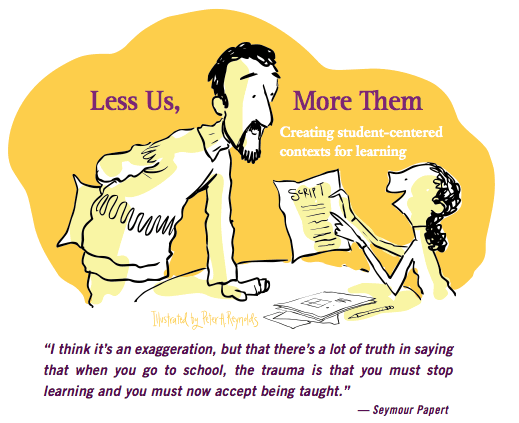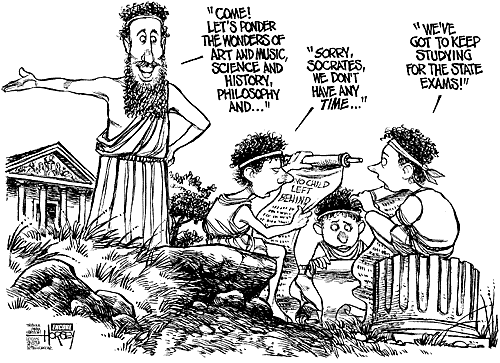Literature on project based learning for K 12
Keywords | search strategy:
project-based learning, kindergarten to high school, online leaching ? Online learning? Methodology? Online platforms.
старо но точно по темата:
Cathy Cavanaugh, & Kara Dawson. (2010). Design of Online Professional Development in Science Content and Pedagogy: A Pilot Study in Florida. Journal of Science Education and Technology, 19(5), 438–446. https://doi.org/10.1007/s10956-010-9210-2
https://mnpals-scs.primo.exlibrisgroup.com/permalink/01MNPALS_SCS/ppvqcp/cdi_proquest_journals_2259584669
flipped classroom зависи от културни особености. това изследване може да важи за Щатите, но не за България:
Raffaghelli, J. (2017). Does Flipped Classroom work? Critical analysis of empirical evidences on its effectiveness for learning. Form@re : Open Journal Per La Formazione in Rete, 17(3). https://doi.org/10.13128/formare-21216
https://mnpals-scs.primo.exlibrisgroup.com/permalink/01MNPALS_SCS/ppvqcp/cdi_doaj_primary_oai_doaj_org_article_589dc480fa9a48cd828561173c625b39
изследване от Турция
Şahin, S., & Baturay, M. (2016). The effect of 5E-learning model supported with WebQuest media on students’ achievement and satisfaction. E-Learning and Digital Media, 13(3-4), 158–175. https://doi.org/10.1177/2042753016672903
https://mnpals-scs.primo.exlibrisgroup.com/permalink/01MNPALS_SCS/ppvqcp/cdi_crossref_primary_10_1177_2042753016672903
изследване от Гърция|
Georgios FESSAKIS, & Stavroula PRANTSOUDI. (2019). Computer Science Teachers’ Perceptions, Beliefs and Attitudes on Computational Thinking in Greece. Informatics in Education, 18(2), 227–258. https://doi.org/10.15388/infedu.2019.11
Lee, D., Huh, Y., Lin, C., & Reigeluth, C. (2018). Technology functions for personalized learning in learner-centered schools. Educational Technology Research and Development, 66(5), 1269–1302. https://doi.org/10.1007/s11423-018-9615-9
https://mnpals-scs.primo.exlibrisgroup.com/permalink/01MNPALS_SCS/ppvqcp/cdi_proquest_journals_2071965296
Brookes, T. (2017). Design challenges: Connecting the classroom to the real world. Teaching Science, 63(4), 16–19. Retrieved from http://eric.ed.gov/ERICWebPortal/detail?accno=EJ1165661
https://mnpals-scs.primo.exlibrisgroup.com/permalink/01MNPALS_SCS/ppvqcp/cdi_proquest_journals_1979139411
училищен библиотекар да работи с преподавател над учебен план много трудно ще стане в съврменна България, но не е невъзможно:
Boyer, B. (2015). Designer Librarian: Embedded in K12 Online Learning. 59(3), 71–76. https://doi.org/10.1007/s11528-015-0855-9
https://mnpals-scs.primo.exlibrisgroup.com/permalink/01MNPALS_SCS/ppvqcp/cdi_proquest_journals_1675592618
Educause прогнозира нарастваща роля на instructional designer при съставянето на учебни планове: e.g. https://blog.stcloudstate.edu/ims/2019/04/24/2019-educause-horizon-report/; https://blog.stcloudstate.edu/ims/2018/11/09/new-directions-in-instructional-design/; https://blog.stcloudstate.edu/ims/2019/01/06/future-of-libraries-with-instructional-design/; https://blog.stcloudstate.edu/ims/2017/01/04/instructional-design-librarian-2/
Lindsey M Swagerty, & Tara Hodge. (2019). fostering creativity and curiosity: developing safer elementary STEM learning spaces. Technology and Engineering Teacher, 78(8), 20–23. Retrieved from https://search.proquest.com/docview/2226390222
https://mnpals-scs.primo.exlibrisgroup.com/permalink/01MNPALS_SCS/ppvqcp/cdi_proquest_journals_2226390222
Tandra L. Tyler-Wood, Deborah Cockerham, & Karen R. Johnson. (2018). Implementing new technologies in a middle school curriculum: a rural perspective. Smart Learning Environments, 5(1), 1–16. https://doi.org/10.1186/s40561-018-0073-y
https://mnpals-scs.primo.exlibrisgroup.com/permalink/01MNPALS_SCS/ppvqcp/cdi_doaj_primary_oai_doaj_org_article_6b4a31d0f8b9471bbe2d291cba18719b
Justin Weidman, & Geoffrey Wright. (2019). promoting construction education in K-12 by using an experiential, student-centered, STEM-infused construction unit. Technology and Engineering Teacher, 79(1), 8–12. Retrieved from https://search.proquest.com/docview/2309762278
https://mnpals-scs.primo.exlibrisgroup.com/permalink/01MNPALS_SCS/ppvqcp/cdi_proquest_journals_2309762278
това е за твоя офис за професионално ориентиране:
Destinations Career Academies Offer Support to Schools, Families Disrupted by Coronavirus (p. 68–). (2020). NewsRX LLC.
https://mnpals-scs.primo.exlibrisgroup.com/permalink/01MNPALS_SCS/ppvqcp/cdi_gale_healthsolutions_A617560083
Schachter, R. (2013). Project-based learning 2.0: technology pushes PBL into fifth gear in K12. 49(12), 60–.
https://mnpals-scs.primo.exlibrisgroup.com/permalink/01MNPALS_SCS/ppvqcp/cdi_gale_infotracacademiconefile_A353319541
Lee, D., Huh, Y., Lin, C., & Reigeluth, C. (2018). Technology functions for personalized learning in learner-centered schools. Educational Technology Research and Development, 66(5), 1269–1302. https://doi.org/10.1007/s11423-018-9615-9
https://mnpals-scs.primo.exlibrisgroup.com/permalink/01MNPALS_SCS/ppvqcp/cdi_proquest_journals_2071965296
From ResearchGate:
Amissah, P. (2019). ADVANTAGES AND CHALLENGES OF ONLINE PROJECT-BASED LEARNING [MS Media Arts and Technology]. https://www.researchgate.net/publication/336614010_ADVANTAGES_AND_CHALLENGES_OF_ONLINE_PROJECT-BASED_LEARNING
Ching, Y.-H., & Hsu, Y.-C. (2011). Incorporating peer feedback for learning in a project-based online learning environment. ResearchGate. https://www.researchgate.net/publication/277987113_Incorporating_peer_feedback_for_learning_in_a_project-based_online_learning_environment
Handoyono, N. A., & Rabiman, R. (n.d.).
(PDF) Improvement of Learning Motivation and Learning Outcomes by Applying The Problem Based-Learning Method. ResearchGate. Retrieved March 22, 2020, from
https://www.researchgate.net/publication/338796878_Improvement_of_Learning_Motivation_and_Learning_Outcomes_by_Applying_The_Problem_Based-Learning_MethodTran, T. Q., & Ngoc Tu, T. P. (2019). (PDF) The Important Roles of Project-Based Learning in Teaching English to High School Students.
ResearchGate.
https://www.researchgate.net/publication/333935026_The_Important_Roles_of_Project-Based_Learning_in_Teaching_English_to_High_School_StudentsZakaria, A., Salleh, A., Ismail, Mohd. S., & Ghavifekr, S. (2019).
(PDF) Cultivating Positive Values via Online Project-Based Module (m-PAT). ResearchGate.
https://www.researchgate.net/publication/334044540_Cultivating_Positive_Values_via_Online_Project-Based_Module_m-PATFrom Academia.com
VIA (very important article):
McDougall, J., Readman, M., & Wilkinson, P. (2018). The uses of (digital) literacy. Learning, Media and Technology, 43(3), 263–279. https://doi.org/10.1080/17439884.2018.1462206










